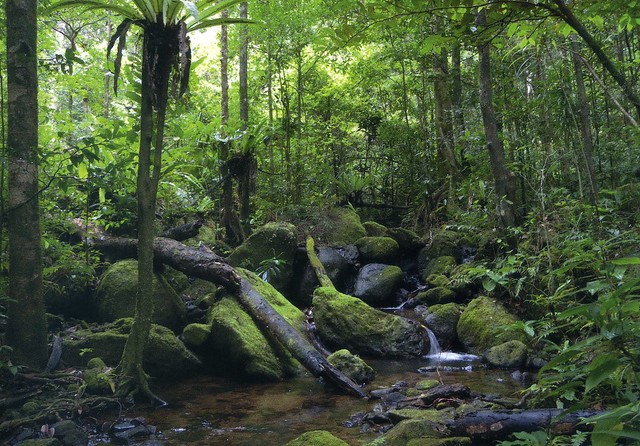Today's last card is from a swap from earlier this year. It's also my first postcard from Madagascar - and it's written and stamped, too!
The Rainforests of the Atsinanana comprise six national parks distributed along the eastern part of the island. These relict forests are critically important for maintaining ongoing ecological processes necessary for the survival of Madagascar’s unique biodiversity, which reflects the island’s geological history. Having completed its separation from all other land masses more than 60 million years ago, Madagascar’s plant and animal life evolved in isolation. The rainforests are inscribed for their importance to both ecological and biological processes as well as their biodiversity and the threatened species they support. Many species are rare and threatened especially primates and lemurs.
Madagascar, then, is an island country in the Indian Ocean, off the coast of Southeast Africa. The nation comprises the island of Madagascar (the fourth-largest island in the world), as well as numerous smaller peripheral islands. Following the prehistoric breakup of the supercontinent Gondwana, Madagascar split from India around 88 million years ago, allowing native plants and animals to evolve in relative isolation. Consequently, Madagascar is a biodiversity hotspot; over 90 percent of its wildlife is found nowhere else on Earth. The island's diverse ecosystems and unique wildlife are threatened by the encroachment of the rapidly growing human population and other environmental threats.
Initial human settlement of Madagascar occurred between 350 BC and AD 550 by Austronesian peoples arriving on outrigger canoes from Borneo. These were joined around AD 1000 by Bantu migrants crossing the Mozambique Channel from East Africa. Other groups continued to settle on Madagascar over time, each one making lasting contributions to Malagasy cultural life. The Malagasy ethnic group is often divided into eighteen or more sub-groups of which the largest are the Merina of the central highlands.
Until the late 18th century, the island of Madagascar was ruled by a fragmented assortment of shifting socio-political alliances. Beginning in the early 19th century, most of the island was united and ruled as the Kingdom of Madagascar by a series of Merina nobles. The monarchy collapsed in 1897 when the island was absorbed into the French colonial empire, from which the island gained independence in 1960. The autonomous state of Madagascar has since undergone four major constitutional periods, termed Republics. Since 1992 the nation has officially been governed as a constitutional democracy from its capital at Antananarivo. However, in a popular uprising in 2009 president Marc Ravalomanana was made to resign and presidential power was transferred in March 2009 to Andry Rajoelina in a move widely viewed by the international community as a coup d'état. Constitutional governance was restored in January 2014 when Hery Rajaonarimampianina was named president following a 2013 election deemed fair and transparent by the international community.
In 2012, the population of Madagascar was estimated at just over 22 million, 90 percent of whom live on less than two dollars per day. Malagasy and French are both official languages of the state. The majority of the population adheres to traditional beliefs, Christianity, or an amalgamation of both. Ecotourism and agriculture, paired with greater investments in education, health and private enterprise, are key elements of Madagascar's development strategy. Under Ravalomanana these investments produced substantial economic growth but the benefits were not evenly spread throughout the population, producing tensions over the increasing cost of living and declining living standards among the poor and some segments of the middle class. As of 2014, the economy has been weakened by the recently concluded political crisis and quality of life remains low for the majority of the Malagasy population.
Subscribe to:
Post Comments (Atom)




 Maroon
Maroon 










































































































































































No comments:
Post a Comment